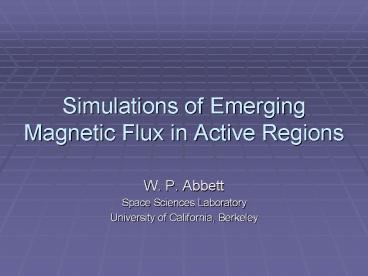Simulations of Emerging Magnetic Flux in Active Regions PowerPoint PPT Presentation
Title: Simulations of Emerging Magnetic Flux in Active Regions
1
Simulations of Emerging Magnetic Flux in Active
Regions
- W. P. Abbett
- Space Sciences Laboratory
- University of California, Berkeley
2
Toward a Global View of Emergence
- Interior Modeling Evolution of flux ropes deep
in the Convection Zone - Surface Layers Modeling the evolution of
magnetic features at the solar surface - The Local Corona Evolution of the coronal
field in response to magnetic flux emerging
through the photosphere - Global models of the solar corona
- Coupled models Can we achieve a more holistic
picture?
3
Interior Modeling
The Flux Tube Picture Toroidal flux layer near
the tachocline succumbs to an instability, and
creates a buoyant flux rope that ascends through
the CZ as an Omega-loop. The loop emerges
through the photosphere, and is observed as a
magnetic bipole.
(Cauzzi et al. 1996)
4
- Modeling the Interior
- The Thin Flux Tube Approximation
- Assumptions
- Active region fields behave as distinct,
tube-like entities - embedded in a field-free plasma. The flux
tube diameter - is small compared with all other relevant
length scales, - and pressure balance exists across the tube
at all times. - Advantages
- One can derive a simplified equation of
motion for a 1D - tube moving within a 3D model of the solar
interior.
5
- Modeling the Interior
- The Thin Flux Tube Approximation
- Successes
- Certain observational properties of active
regions can - be addressed for example, distribution of
active region - tilt angles (Longcope Fisher 1996), and
asymmetric - spot motions and morphologies (Caligari et
al. 1995, - Fan Fisher, 1996).
6
- Modeling Flux Ropes in the CZ
- 3D local MHD in the anelastic approximation
- Assumptions
- Approximation results from a scaled variable
expansion of - the 3D MHD equations about a zero-th order,
stratified - reference state. This approximation is valid in
the high beta, - gravitationally stratified plasma of the solar
convection zone - below the photosphere.
- Advantages
- Fast-moving acoustic waves are effectively
filtered out of the - simulations. Time steps are less restrictive,
and a large - amount of parameter space can be explored.
7
Modeling Flux Ropes in the interior
3D vs 2D axisymmetric (Abbett et al. 2000,2001)
8
Of interest Highly twisted, knotted
configurations (Linton, Fan, Fisher)
Kink unstable magnetic flux tube rising through a
stratified model CZ (LHS using ANMHD Fan et al.
1999) and evolving in a non-stratified domain
using the periodic spectral code, CRUNCH-3D (RHS
Linton et al. 1999).
9
Delta Spot Active Regions modeled as buoyant,
initially kink-unstable flux tubes that emerge
through CZ
Q Is emerging flux (especially in highly
sheared configurations) an important component of
the CME initiation process?
10
ANMHD Examples LHS --- magneto-convection and
the local solar dynamo RHS --- emerging
magnetic flux (Abbett, Fan Fisher 2002 in prep).
11
Surface Layers
- A fully compressible treatment is required.
- Two approaches for modeling magnetic fields at or
near the solar surface - 1. Realistic radiative-magnetoconvection over
- small spatial scales (Stein Nordlund
2001, - Bercik 2002, Gudiksen et al. 2002)
- 2. 3D MHD simulation of the local photosphere
/ - transition region / low corona employing
- an approximate treatment of the energy
equation - (Fan 2001, Magara Longcope 2001)
12
Surface Layers
- Granular-scale surface magneto-convection
- (Bercik 2002)
- Computationally expensive calculation
- thus, the domain size is restricted.
13
Surface Layers Modeling Large-scale Flux
Emergence into the Corona
- Zeus3D fully-compressible
- 3D ideal MHD (Fan 2001)
- Calculations of this
- type are important to
- test theoretical models
- of CME initiation.
- Do flux ropes exist in
- the corona, and can they
- be formed self-consistently
- through emergence of a
- twisted magnetic structure
- from below?
- Are multipolar magnetic
- configurations necessary
- prerequisites for an
- eruptive event?
14
Surface Layers Modeling Large-scale Flux
Emergence into the Corona
Fully-compressible 3D ideal MHD (Magara
Longcope 2001)
15
2.5-D simulation of how a layer of magnetic field
can spontaneously shear as a result of a
mixed-mode buoyancy instability (Manchester 2001).
16
Toward Coupled models of Flux Emergence
- PARAMESH A domain decomposition, adaptive
mesh refinement (AMR) framework developed by
MacNeice et al. 2000 and distributed by GSFC - Zeus3D A staggered mesh finite-difference
(non-relativistic) MHD code originally developed
by Stone Norman 1992, and publicly distributed
by NCSA - ZeusAMR A fully compressible 3D MHD code with
AMR which resulted from a merge of PARAMESH with
a modified version of Zeus3D
17
Toward Coupled Models of Flux Emergence
- ANMHD Interior model
- drives the lower boundary
- of a Zeus3D model
- corona (Abbett in prep
- 2002).
- Code coupling Does
- the corona significantly
- affect the sub-surface
- calculation (Welsch
- Longcope 2000)
- How important are
- treatments of the
- energy equation in
- the transition layers
- and corona (Mikic,
- Linker, Lionello, Mok
- 2002)?
18
Example of driving a ZeusAMR coronal simulation
with an ANMHD generated lower boundary. True
code coupling can be achieved using the
PARAMESH framework.
19
Toward Coupled Models of Flux Emergence Summary
- Existing code coupling frameworks have the
potential to provide a straightforward way to
self-consistently connect existing numerical
treatments of local flux emergence into
large-scale models of global phenomena. - Though, the devil is in the details
- -- Different numerical algorithms,
boundary treatments, and physical conditions
between individual models of different regimes
make the task of transferring information back
and forth between codes in a suitably efficient,
yet physically consistent manner, a non-trivial
task.

